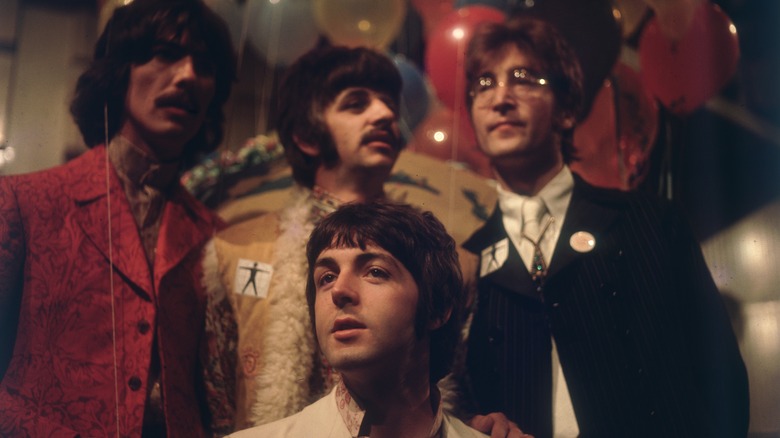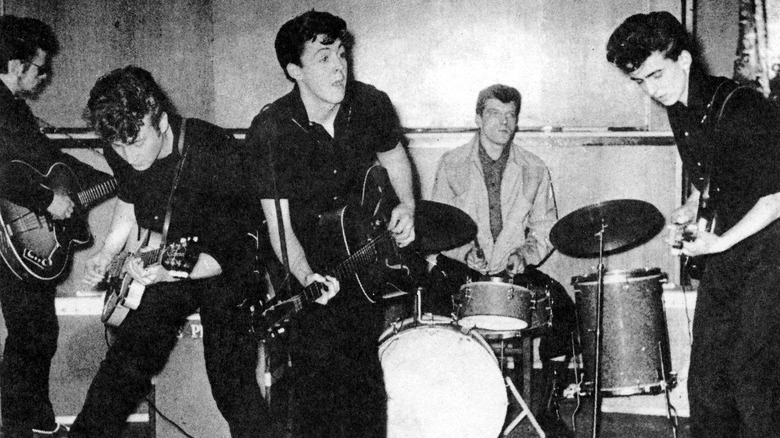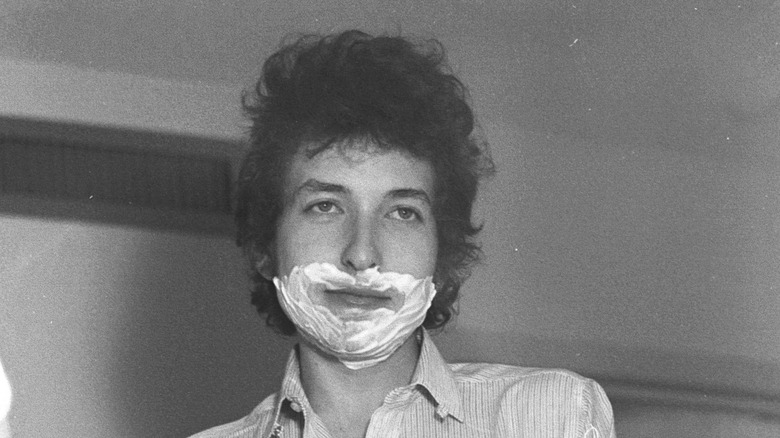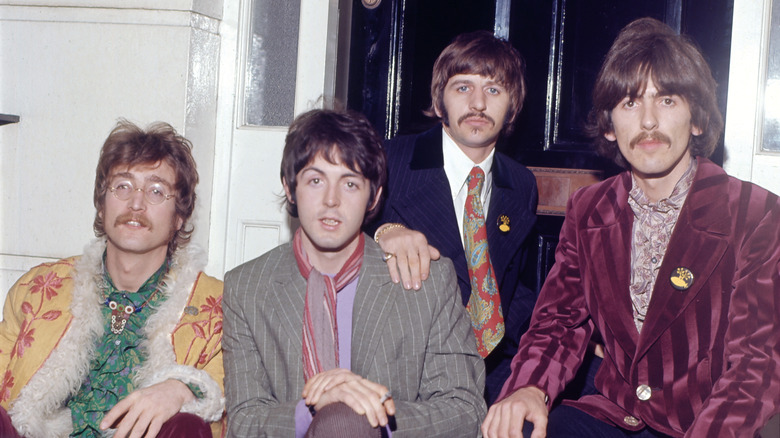The History Of The Beatles' Drug Use Explained
When The Beatles first took over the world in the early 1960s to become the era's definitive rock 'n' roll band, they did so with a clean-cut image that would endear them to millions of teenage girls (even as their unusually shaggy hair may have drawn the ire of their parents). Despite their obvious talent, few who would have seen them on their breakout performance on "The Ed Sullivan Show" in 1964 would have expected that The Beatles would be the band to usher in the psychedelic era of the end of the decade and produce records as mind-bending and groundbreaking as "Rubber Soul," "Revolver" and, perhaps their greatest achievement, "Sgt. Pepper's Lonely Hearts Club Band."
Much of the transformation that took place in the creative lives of John Lennon, Paul McCartney, George Harrison, and Ringo Starr — as well as in larger Western society — did so in part due to experimentation with drugs, chiefly those associated with the counterculture movement of the 1960s. Cannabis and hallucinogens such as LSD were believed to open the mind to new perspectives and aid creativity. But while the late 1960s was the apex of The Beatles' drug journey as well as their creative peak, their use of drugs began long before they were superstar musicians, and went on long after the Fab Four split in 1970. Here is how drugs featured in the lives of some of the most lauded musicians of all time.
High-octane performances
Though it is The Beatles' studio albums and singles that have been the most enduring part of their legacy, their abilities as a live band before they decided to quit touring in 1966 were also exceptional. As well as the foursome's innate talent and musicality, much of their skill came as a result of periods earlier in their career of widespread touring and intensive residencies at clubs in the U.K., particularly their home city of Liverpool, and in Hamburg, Germany, where they were a popular draw for sailors during long, late-night drinking sessions. Slate claims that during the Hamburg days in the early 1960s The Beatles played around 250 nights in the port in a two year period, and often played as long as five hours a night.
The Beatles were all either teens or had just turned 20 during their Hamburg period, but even young lads would find such an arduous gigging schedule heavy going. As they later admitted, the band — like many others of the period — kept their energy levels up with the use of stimulants. As the Fab Four recall in "The Beatles Anthology," their drug of Preludin, which was also used by waiters to help them cope with working long shifts on their feet. The Beatles Bible claims that Preludin was actually a German weight loss drug. John Lennon and George Harrison also recalled taking the drug Benzedrine while they were in Liverpool, which a friend showed them how to extract from the back of an inhaler.
Chillin' with Dylan
It is difficult to think of the 1960s and the hippy movement that emerged from it without considering the prevalence of marijuana, or as it was more commonly known during the '60s "pot." Pot emerged from the jazz and beat scenes of the 1940s and 1950s to become a major youth trend in the decade that followed, which panicked many American parents. "The soft sweet smell of marijuana hangs in the streets of San Francisco, New York, Atlanta, Detroit, Seattle. People pass on the sidewalk looking stoned, wearing buttons saying 'Turned On' or 'Let's Get Naked and SMOKE,'" read a line from Life magazine in 1967 which declared a whole generation risked having their lives ruined by the drug (via Time).
But despite their hard-partying days in Liverpool and Hamburg, the Fab Four reportedly didn't encounter pot — or smoke it at least — until they were already famous. And when they did, it was through a true counterculture icon: Bob Dylan, whom they had met for the first time backstage after a concert in 1964. Beatles drummer Ringo Starr told Conan O'Brien (via YouTube) about the experience, saying, "We got high and laughed our asses off." Starr elaborated, saying "I went first. The drummers always go first. That's how it was. We didn't draw lots or anything like that." The experience led to the band becoming regular pot smokers after that.
Psychedelics
The drugs most central to The Beatles' countercultural identity are psychedelics, which it is said underpinned many of their most out-there music. John Lennon in particular became an ardent user of LSD, and would often spend long periods at home high. All of The Beatles used the drug, although their introduction to it was forced upon them. According to Rolling Stone, Lennon, George Harrison, and their wives Linda and Patty were each unwittingly given a dose by their friend John Riley who put LSD-laced sugar cubes in their coffee. Though the experience was at first unnerving, Lennon and Harrison then introduced their bandmates to the drug, including the reportedly hesitant Paul McCartney.
Per Rolling Stone, LSD was especially influential on the album "Revolver," and is said to have been referenced through the initials of the Lennon-penned "Lucy in the Sky with Diamonds." Though Lennon refuted this notion in a 1970 Rolling Stone interview, McCartney claimed years later that most of the drug references in their music were intentional (via The Washington Post).
However, Ringo Starr is adamant that he and his fellow Beatles tried to use drugs away from the studio and actual recording sessions (per Pop Matters). When working in the studio, they tended to drink tea and smoke cigarettes, the latter of which was consumed by more than 42% of Americans in 1965 with similar statistics for smoking in Great Britain, per ASH.
Hard drugs took hold
But The Beatles' drug use wasn't all about peace and love. In the final years of the band, John Lennon, along with his new partner, the artist and musician Yoko Ono, developed a dependence on heroin. The pair began using dangerous drug derived from opium in 1968, with Lennon eventually growing withdrawn from the band and less professional in terms of writing and recording. Lennon later went public about his struggles with the drug, penning the song "Cold Turkey" to describe the anxiety during the process of ending his dependence.
One drug less associated with The Beatles but which was certainly present was cocaine, which Paul McCartney admitted he took regularly for about a year around the release of "Sgt. Pepper" in 1967. Lennon used cocaine in the 1970s and can be heard snorting the drug on the bootleg "A Toot and a Snore in '74," his last recording with McCartney who describes his memory of the recording as "hazy, for a number of reasons" (per Open Culture). McCartney also told the Daily Mirror in 2004 that he had once smoked heroin without realizing it after someone handed it to him at a gathering (via The Washington Post).
The Beatles and drugs in later life
John Lennon's life had calmed down a lot by the time of his tragic murder in December 1980. He was 40 years old, and though he had famously spent 18 months of the early '70s in a drug and alcohol-fuelled "lost weekend," by the time of his death he was relatively sober, though he claimed in a Playboy interview to still trip occasionally with hallucinogens such as psilocybin mushrooms and peyote. Harrison also continued to take drugs, particularly cocaine, in middle age, which affected his personal relationships.
Ringo Starr's use of drugs also went beyond the creative experimentation the band claimed it offered them in the mid to late '60s. He has been open about his heavy use of cocaine, which peaked for the drummer in the 1970s, alongside a drinking habit that saw him consume multiple bottles of wine a day. However, he has now been sober for more than 30 years, with outlets such as the New Zealand Herald praising Starr for his youthful looks as he enters his ninth decade despite his famously hard-partying youth.
One might assume that Paul McCartney, whose longevity is arguably even more miraculous than that of Starr what with his near-constant writing, recording, touring, and countless side projects, might have kicked drugs a long time ago. However, the "Hey Jude" singer shocked many of his fans in 2023, when at the age of 80 he was spotted smoking what looks suspiciously like an enormous joint, a clip of which you can view above.
If you or anyone you know needs help with addiction issues, help is available. Visit the Substance Abuse and Mental Health Services Administration website or contact SAMHSA's National Helpline at 1-800-662-HELP (4357).



